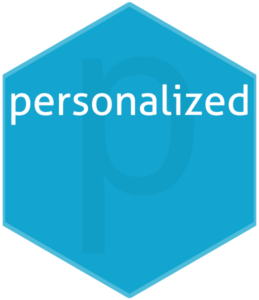*Free registration is required to use the toolkits provided within HIPxChange. This information is required by our funders and is used to determine the impact of the materials posted on the website.
 The ‘personalized’ package is an R software package designed for the analysis of data where the effect of a treatment or intervention may vary for different patients.
The ‘personalized’ package is an R software package designed for the analysis of data where the effect of a treatment or intervention may vary for different patients.
The package allows you to construct models that estimate the differential treatment effects and then use these estimates to make treatment or intervention recommendations for patients. The recommendations are designed to maximize or minimize an outcome of interest across the population.
This package can be used for either data from randomized controlled trials or observational studies, and is not limited specifically to the analysis of medical data.
Key References
- Chen S, Tian L, Cai T, Yu M. A general statistical framework for subgroup identification and comparative treatment scoring. Biometrics. 2017 Dec;73(4):1199-1209.
- Huling JD, Yu M. Subgroup identification using the personalized package. J Stat Softw. 2021 May;98(5):1-60.
Who should use this program?
The ‘personalized’ R package is intended for analysts who seek to improve the delivery of care by making informed decisions about which patients should be enrolled in interventions.
What does the program contain?
The R package contains functions for fitting subgroup identification models. The program can be used to:
- Perform a subgroup identification analysis
- Evaluate treatment or intervention effects within the estimated subgroups
Complete documentation of the functionality of the program and usage instructions are contained in the reference manual and vignette document located here: https://cran.r-project.org/web/packages/personalized/index.html
Installing the personalized R package
Before you can use the personalized R package, a recent version of R must be downloaded and installed from CRAN at https://cran.r-project.org/.
Once R is installed, you can install the personalized package by running the following R command:
install.packages("personalized")
Using the personalized R package
Once the package is successfully installed, to utilize it, you must load the package via the following R command:
library(personalized)
For more information about the package requirements, visit https://cran.r-project.org/web/packages/personalized/index.html.
A brief usage overview is available here: https://cran.r-project.org/web/packages/personalized/readme/README.html and a thorough overview of the underlying methodology and detailed information about the usage of the package is available here: https://arxiv.org/abs/1809.07905.
Documentation of each function is provided in standard R documentation format here: https://cran.r-project.org/web/packages/personalized/personalized.pdf and a better organized version of the same documentation is available here: https://jaredhuling.github.io/personalized/reference/index.html.
Development of this program
The personalized R package was developed by researchers and clinicians (Principal Investigator: Jared Huling) at the University of Wisconsin-Madison School of Medicine & Public Health – Department of Biostatistics and Medical Informatics and The Ohio State University – Department of Statistics.
We would like to thank Aaron Potvien for his contribution to this project.
This project was supported by the Patient-Centered Outcomes Research Institute (PCORI) Award ME-1409-21219 (PI: Menggang Yu). All statements in this paper, including its findings and conclusions, are solely those of the authors and do not necessarily represent the views of the PCORI, its Board of Governors or Methodology Committee. Additional support was provided by the University of Wisconsin School of Medicine and Public Health’s Health Innovation Program (HIP), the Wisconsin Partnership Program, and the Community-Academic Partnerships core of the University of Wisconsin Institute for Clinical and Translational Research (UW ICTR), grant 9 U54 TR000021 from the National Center for Advancing Translational Sciences (previously grant 1 UL1 RR025011 from the National Center for Research Resources). The content is solely the responsibility of the authors and does not necessarily represent the official views of the National Institutes of Health or other funders.
Please send questions, comments and suggestions to HIPxChange@hip.wisc.edu
Toolkit Citation
Huling JD, Yu M. Subgroup identification using the personalized package. J Stat Softw. 2021 May;98(5):1-60.


